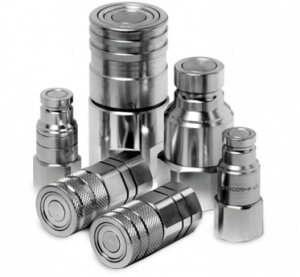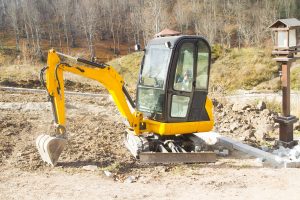Flat face hydraulic couplers are essential components in hydraulic systems, designed to provide reliable, leak-free connections in demanding environments. These couplers are widely used across construction, agriculture, and industrial applications due to their durability, contamination resistance, and ease of use.
Choosing the right size—such as the commonly used 3/4 flat face hydraulic couplers—is critical for ensuring safe operation, maintaining system pressure, and delivering optimal flow rates. Whether you’re replacing a worn coupler or outfitting new equipment, accurate measurement is the key to long-lasting performance and compatibility. Explore the full range of flat face hydraulic couplers on our Flat Face Couplers product page.
Why Measuring Flat Face Couplers Matters
Incorrectly sized couplers can lead to a variety of hydraulic system issues, from slow performance to serious safety hazards. Undersized couplers may restrict flow and increase pressure drop, causing overheating and system inefficiency. Oversized or mismatched couplers can result in connection failures, leaks, and even damage to hydraulic components.
This is especially important in industries like:
- Construction – where equipment like skid steers, mini excavators, and loaders rely on efficient quick couplers for various attachments.
- Agriculture – where hydraulic implements require consistent flow and leak-free operation in all weather conditions.
- Material Handling – where uptime and speed are crucial for productivity and safety.
Properly measured and fitted flat face hydraulic couplers minimize the risk of leaks, ensure secure connections, and help maintain optimal system performance. In short, getting the size right reduces downtime and protects your equipment investment.
Understanding Coupler Sizes
When selecting a hydraulic coupler, understanding the sizing terminology is crucial. Flat face coupler dimensions are often misunderstood, which can lead to incompatible fittings and compromised system performance.
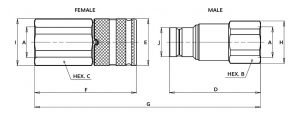 Here are the key dimensions to know:
Here are the key dimensions to know:
- Nominal Size: This refers to the internal flow diameter of the coupler, not the external thread size. For example, 3/4 flat face hydraulic couplers typically allow 3/4″ of internal flow, which impacts the system’s fluid dynamics and pressure. It’s the most common reference when identifying a coupler size.
- Coupler Body Size: The physical body diameter or external dimensions of the coupler, which can vary by manufacturer. While not standardized like nominal flow size, body size may affect your equipment’s available space for installation and access.
- Port Size vs. Flow Diameter: Port size refers to the thread or fitting type used to connect the coupler to your hydraulic line. It’s possible to have a 3/4″ nominal flow coupler with a different thread size, such as 1/2” NPT or SAE. That’s why it’s important to match both flow diameter and port thread type when selecting a coupler.
Remember: when someone refers to a “3/4 flat face hydraulic coupler,” they’re talking about the nominal internal flow path—not the external thread dimensions.
How to Measure Flat Face Couplers
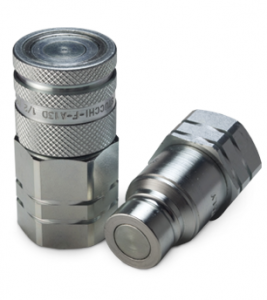 To ensure compatibility with your hydraulic equipment, follow these steps to accurately measure a flat face hydraulic coupler:
To ensure compatibility with your hydraulic equipment, follow these steps to accurately measure a flat face hydraulic coupler:
- Measure the Body Size
Use calipers or a precise ruler to measure the external diameter of the coupler body. This helps identify the series or family if the nominal size isn’t immediately visible. - Measure the Thread
If the coupler is threaded, measure the outside diameter of the male threads or the inside diameter of the female threads. Determine the thread type—NPT, BSP, SAE, or metric—using thread pitch gauges if needed.
→ Visit our Port Thread Specifications resource for help identifying thread standards. - Confirm the Flow Diameter
Identify the size of the internal fluid path, which determines the coupler’s nominal size (e.g., 3/4”). This is typically listed by the manufacturer but can be estimated by measuring the internal bore. - Match Coupler and Port Threads
Be sure that your selected coupler’s threads match the port on your equipment. Even if the nominal size is correct, mismatched threads can lead to leaks or failure. Use adapters only when absolutely necessary, and never force threads to connect.
Correct measurement ensures a proper seal, consistent flow, and a reliable connection under pressure. If you’re unsure, consult with a hydraulic specialist or refer to manufacturer specifications for guidance.
Beyond Measurement: What Else to Consider When Selecting a Flat Face Coupler
While measuring flat face couplers is essential, size alone doesn’t guarantee optimal performance. To ensure you’re selecting the right coupling for your hydraulic system, it’s important to consider factors like pressure ratings, fluid compatibility, environmental conditions, and more. The following sections outline best practices and helpful Stucchi resources to guide you through the selection process.
1. Understand Port Thread Types
Even if your coupler’s nominal size is correct, mismatched threads can lead to leaks or improper connections. Understanding port thread types helps you ensure your coupler is compatible with your equipment’s ports.
Couplers can be equipped with various thread types including:
- NPT (National Pipe Thread)
- BSP (British Standard Pipe)
- SAE (Society of Automotive Engineers)
- Metric threads
Learn how to identify each type and avoid connection issues by reviewing our detailed guide: Common Port Thread Types
2. Use the S.T.A.M.P. Method for Accurate Coupler Selection
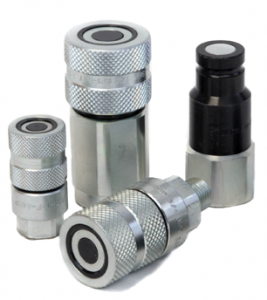 Selecting the right flat face hydraulic coupler involves more than just matching the size. To ensure full compatibility and long-term reliability, use the S.T.A.M.P. method—a proven framework for evaluating five essential criteria:
Selecting the right flat face hydraulic coupler involves more than just matching the size. To ensure full compatibility and long-term reliability, use the S.T.A.M.P. method—a proven framework for evaluating five essential criteria:
- S = Size – Ensure the coupler matches your system’s flow requirements.
- T = Temperature – Know the temperature range of both the media and the environment to select proper sealing materials.
- A = Application – Consider impulse frequency, flow direction, connection frequency, and any external loads.
- M = Media – Confirm material and seal compatibility with hydraulic fluid or other media.
- P = Pressure – Match the coupler’s working and burst pressure ratings to your system’s operating conditions.
Using the STAMP method ensures that all operational variables are accounted for—not just size—helping prevent leaks, equipment failures, or mismatched components.
📘 Learn more: Using the S.T.A.M.P. Method to Select Proper Quick Couplings
🎥 Watch the Video
3. Consider Working and Burst Pressure Ratings
Pressure ratings are one of the most important factors when selecting hydraulic couplers. The working pressure defines the maximum pressure the coupler can handle under normal operating conditions, while the burst pressure is the point at which the component could fail.
Choosing a coupler without the appropriate pressure capacity can lead to:
- Unsafe system failures
- Damaged components
- Leaks and environmental hazards
Size also plays a role in pressure-related performance. An undersized coupler can restrict flow, increase pressure drop, and cause overheating during extended operation.
📘 Learn more: Understanding Working and Burst Pressure Ratings
🎥 Watch the Video
4. Consider Pressure Drop in System Design
Even if your coupler meets the correct size and pressure ratings, pressure drop across the connection can still impact your system’s efficiency. Pressure drop results from friction, fluid viscosity, hose length, or internal flow restrictions.
By evaluating pressure drop, you can:
- Optimize flow and response times
- Prevent overheating
- Extend the life of your hydraulic components
Understanding how each component contributes to pressure drop is key to choosing the best coupler for the job.
📘 Learn more: Understanding Hydraulic Pressure Drop
🎥 How to Estimate Pressure Drop
By combining precise measurement with a comprehensive understanding of pressure, flow, and application needs, you can confidently select the right flat face hydraulic coupler for safe, reliable, and efficient performance. Need help? Contact Stucchi’s hydraulic experts for personalized support.
Common Sizes and Applications
Flat face hydraulic couplers are available in a range of sizes to suit various flow requirements and applications. Below is a quick reference for commonly used sizes and their typical applications:
| Coupler Size | Typical Application |
|---|---|
| 3/8″ | Compact equipment, light-duty attachments |
| 1/2″ | General-purpose hydraulics, skid steers |
| 3/4″ | Mid-size excavators, loaders, and attachments |
| 1″ | High-flow circuits, large construction machinery |
Among these, 3/4 flat face hydraulic couplers are especially popular for their balance of size, flow capacity, and versatility. They are commonly used on mid-size equipment where reliable performance and ease of connection are essential.
Stucchi Flat Face Coupler Solutions
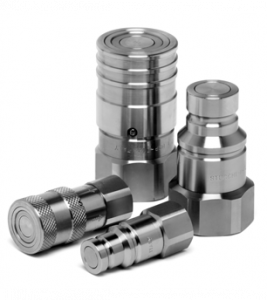 Stucchi offers a full range of flat face hydraulic couplers built for performance, durability, and compatibility with a wide variety of equipment and applications. Whether you’re working in construction, agriculture, or material handling, we have a solution designed to meet your needs.
Stucchi offers a full range of flat face hydraulic couplers built for performance, durability, and compatibility with a wide variety of equipment and applications. Whether you’re working in construction, agriculture, or material handling, we have a solution designed to meet your needs.
Our most popular product lines include:
- APM Series – With CUP (Connection Under Pressure) technology for easy, safe connections.
- FIRG Series – Industry-standard flat face couplers ideal for general-purpose use.
- VEP Series – Threaded flat face couplers for heavy-duty, high-pressure applications.
All series are available in multiple sizes, including the widely used 3/4″ flat face hydraulic couplers.
Explore the Full Flat Face Coupler Product Line
Measuring and selecting the correct flat face hydraulic coupler is critical for maintaining system performance, safety, and compatibility. From understanding port threads to evaluating pressure ratings and flow requirements, every detail counts.
Using tools like the STAMP method and pressure drop analysis, along with Stucchi’s technical resources, ensures you get the most reliable connection for your hydraulic application.
Stucchi offers a wide selection of flat face hydraulic couplers engineered for reliable performance in demanding applications. We provide technical expertise to help you measure and select the right coupler size for your system. Contact us today to find the best solution for your hydraulic connection needs.


